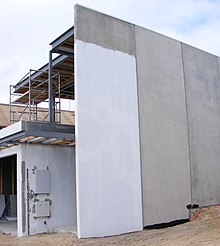Term: Precast concrete
**Overview and History of Precast Concrete:**
– Precast concrete used in interior and exterior applications.
– Controlled environment in precast plant for proper curing.
– Ground-level casting maximizes safety.
– Greater control over material quality and workmanship.
– Reusable forms make precast cheaper than onsite casting.
– Ancient Roman use of concrete in aqueducts.
– Modern precast panelled buildings pioneered in Liverpool in 1905.
– Precast concrete evolution in the US with PCI and NPCA.
– Extensive use of precast concrete in Australia by NSW Government Railways.
– Example of fast precast assembly in the Jim Bridger Building.
**Reinforcement in Precast Concrete:**
– Steel reinforcement improves strength and durability.
– Concrete lacks tension and shear strength.
– Rebar is common concrete reinforcement.
– Steel offers tension and shear strength to concrete.
– Types of rebar include carbon steel, stainless steel, and galvanized steel.
**Products and Applications of Precast Concrete:**
– Agricultural products like bunker silos and cattle feed bunks.
– Building and site amenities include structural components and parking structures.
– Retaining walls made of precast concrete blocks.
– Sanitary and stormwater management products for treatment and removal of pollutants.
– Precast concrete used for sea walls, mechanically stabilized earth panels, and modular block systems.
– Utility structures including hand holes, light pole bases, and transformer pads.
– Water and wastewater products like aeration systems, dosing tanks, and septic tanks.
– Transportation and traffic-related products such as box culverts, bridge systems, and concrete barriers.
– Modular paving for enhanced aesthetic appeal and durability.
– Specialized products like watertight structures, storage containers, and marine products.
**Regulations and Certifications for Precast Concrete:**
– State and federal transportation projects in the US require precast concrete suppliers to be certified.
– Certification from associations like the Architectural Precast Association, National Precast Concrete Association, or Precast Prestressed Concrete Institute.
**Related Concepts and References:**
– Cast in place concrete, the Million Programme, prestressed concrete, roll way systems, and structural robustness in precast concrete buildings.
– References and resources for further reading and information on precast concrete.
Precast concrete is a construction product produced by casting concrete in a reusable mold or "form" which is then cured in a controlled environment, transported to the construction site and maneuvered into place; examples include precast beams, and wall panels for tilt up construction. In contrast, cast-in-place concrete is poured into site-specific forms and cured on site.



Recently lightweight expanded polystyrene foam is being used as the cores of precast wall panels, saving weight and increasing thermal insulation.
Precast stone is distinguished from precast concrete by the finer aggregate used in the mixture, so the result approaches the natural product.
